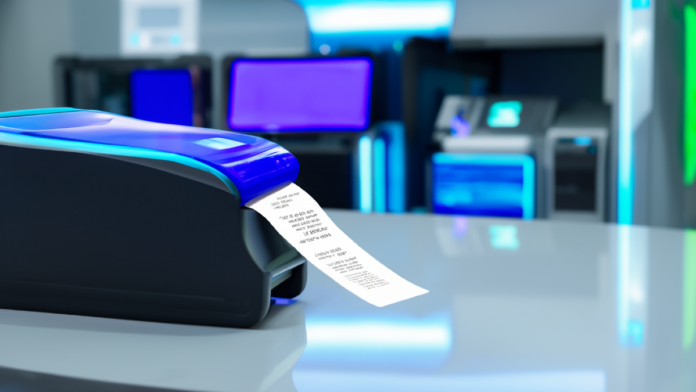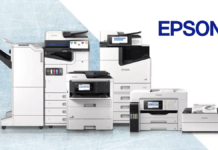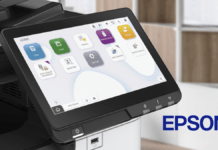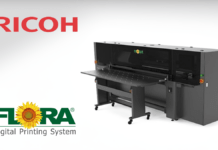Linerless label printers are increasingly in demand among customers in a range of sectors due to various factors, including improvements in productivity and sustainability and this is set to continue for years to come – meaning there are plenty of opportunities for resellers.
While linerless label printers may have been first developed way back in the 1980s, it has been recent years where demand has really taken off for them, as businesses in a range of sectors look to be more sustainable and reduce plastic waste.
Demand is set to continue to grow in the coming years too; it is forecast to grow from $1.9 billion in 2023 to $3 billion by 2033, according to Future Market Insights.
“Growth has largely been fuelled by increased demand for better product visibility and safety as well as a need for more sustainable labelling solutions,” says TSC Printronix country manager for the UK, Ireland and the Nordics, Bob Vines. “We’re seeing a huge increase in interest for linerless label printers especially from the logistics, retail, healthcare, grocery and fast food industries.”
Deyon Antoine, product marketing manager at Toshiba Tec, agrees that demand for linerless label printers is on the rise globally, driven by factors such as sustainability initiatives, cost savings and operational efficiency improvements. “The UK, like many other regions, has been increasingly focused on sustainability and reducing waste,” he says.
“This has led to a growing interest in eco-friendly packaging solutions, including linerless labels. Additionally, businesses are always looking for ways to improve efficiency and reduce costs, making linerless label printers an attractive option due to their potential for streamlining operations.”
Numerous benefits
There are many advantages to linerless label printing over traditional label printing. “The core reason why linerless is gaining interest and backing (pun intended) is its perceived benefit to sustainability,” says Richard Barfield from Zebra. “While linerless has advantages in this area over traditional linered material, like any product, it still leaves a footprint of raw material, energy and greenhouse gas (GHG) utilisation to manufacture, process and transport it.
“Recycling silicone-based backing liner is not easy and therefore most of it will end up in landfill; being able to take this out of the waste chain by switching to linerless – where it makes sense to do so – is a positive step.”
But there are other advantages of linerless for businesses, such as with productivity. “With up to 50% more labels on a roll, and with no need for printer calibration you need less roll changes, giving you more printer uptime,” says Richard.
“It is also easy to use: linerless is a continuous media that is easy to configure. You don’t need to specify the label length. Every label you print on the same roll can be a variable length.”
There is also the safety aspect to consider, Richard adds. “Silicone-based liner material is slippery,” he says. “By omitting piles of it building up on the warehouse or factory floor, you take away a slip hazard for your workers.”
Then there is the cost – often a crucial factor for customers. “Omitting the backing liner means there are no costs associated with sending this waste to landfill, or the liner take-up machinery and staff to collect it,” says Richard. “Even better, with up to 50% more labels on a roll, you can reduce the amount of storage required. Linerless rolls typically weigh 40% less, so again you can make savings with transportation costs, but also carbon dioxide and other GHG emissions.
“We have recently launched our Packing Bench Solution at Zebra, which incorporates one of our Zebra Fixed Industrial Scanners, combined with a linerless desktop printer, and delivers up to 33% productivity enhancement for each packing station.”
Trends
But as demand for linerless printers is increasing, what customers want from them is changing too. “Customers need to be more efficient as well as demonstrate more sustainable practices and linerless labelling enables them to deliver on both counts,” Bob says.
“Because linerless media is supplied as a continuous roll, for which an inline cutter is required to cut the label to its required length, it means that multiple sized labels can be produced from the same roll and only one printer is necessary to print different sized labels, so there’s less media changes, which translates into improved productivity and increased efficiency. More labels per roll means less space required to store them, so the trend is towards lower stock levels.”
Deyon adds that there is increasing demand for sustainable labelling solutions. “Customers are becoming more environmentally conscious and are seeking products with minimal environmental impact,” he says. “This has led to a growing interest in eco-friendly labelling materials, such as recycled paper, biodegradable plastics and linerless labels.”
In addition, with the rise of the Internet of Things, there’s growing interest in smart labels that can communicate information beyond static text and graphics, Deyon notes. “Customers are looking for labels with RFID (Radio Frequency Identification) or NFC (Near Field Communication) capabilities, which can track products throughout the supply chain, provide real-time information to consumers, and enable interactive experiences via smartphones or other devices.
“The growth of ecommerce has led to increased demand for labels that are durable, tamper-evident, and optimised for automated fulfilment processes. Customers expect labels that can withstand shipping and handling, maintain brand integrity, and provide essential information for online shoppers.”
Deyon adds that in crowded marketplaces, brands are increasingly using labels to stand out from competitors. “Eye-catching designs, innovative packaging formats and unique labelling techniques (e.g. embossing, foiling, textured finishes) help brands capture consumers’ attention and create memorable experiences,” he says.
Food and drink demand
One sector in particular that is embracing linerless label printers is food and drink. “This sector is expected to account for a significant share of the linerless labels market as many see the media as a means to improve their carbon neutrality,” says Bob.
“In grocery/fresh food, for example, linerless labels can be used to indicate freshness or expiry date extensions which helps prolong shelf life. Butchers and deli counters can use them for labelling after they’ve weighed items. Fast food operations can use them for labelling food bags in drive throughs. They can be used in shipping and mailing operations, and for postage and parcel labelling.”
Mark Lloyd, sales director, Star Micronics EMEA, agrees. “With the rise in multi-channel ordering in the hospitality industry in recent years accompanied by increasing demand for customer collection, third party delivery and legislation around accurate ingredients and allergy identification, the requirement for efficient food and beverage labelling has surged,” he says. “Without a doubt, among the range of labelling solutions currently available, linerless labels stand out for their eco-friendly properties and operational efficiencies.
“Direct thermal linerless labels are self-adhesive labels that can be applied directly to products or packaging. Such labels are supplied with varying levels of adhesion, from high adhesive permanent labels to low adhesive repositionable labels which can be applied to virtually any surface and be removed easily and reapplied without residue.”
Mark adds that as linerless media is available in a range of widths, it enables businesses to create labels for any product type including larger labels for food deliveries to smaller, more compact beverage labels. “Equally, variable length linerless labels enable the printing of shorter orders or labels with less information on minimal paper, further promoting efficiency.
“Star Micronics has recently introduced its mC-Label3 and TSP143IVSK printers, designed to print permanent and repositionable labels, food orders, delivery and takeaway labels.
“The printers respond to the growing requirement for allergy and food labelling, clear delivery and takeaway customer order labels, particularly with linerless media. Low adhesive, repositionable labels can track an order through the entire preparation process from initial order to delivery, providing the potential for greater order accuracy and efficiency.
“The ability to print different sized and types of labels from one easy-to-use device including variable length food and allergy labels, nutrition information as well as food delivery labels and bag seals from web-based apps or local services is essential.”
Jay Kim, managing director, BIXOLON Europe GmbH, adds that the retail and hospitality industries are also increasingly looking at removable linerless labels. “POS linerless printers are being used for applications such as coffee shops or fast-food restaurants to improve order accuracy or in retail for applications such as click and collect,” he says.
“As well as this, professional desktop linerless printer sales are also booming, and permanent linerless labelling demand is really taking off in industries such as transport and logistics for use in package labelling.”
Reseller tips
While there are opportunities to sell linerless label printers in many sectors, there are certain things that resellers should be emphasising in conversations with customers. “Resellers should market them on their ability to enable faster processing, waste reduction, reduced costs and improved compliance,” says Bob. “It’s also worth promoting the versatility of linerless as they can be used for a wide variety of applications and can be printed any length to allow for more comprehensive information to be included.”
He adds that TSC Printronix has various printers that can support linerless labels, including the Alpha-30L 3-inch and Alpha-40L 4-inch mobile performance printers, Alpha-2R 2-inch performance mobile printer, DA Series performance desktop printers, TH Series desktop barcode printer and the MB240 Series linerless industrial printer.
In addition, it is important to consult a linerless hardware and media expert, Bob says. “It can be challenging to find the right combination of a linerless printer and linerless label that function well together,” he says. “For example, if the adhesive on the label is too strong, the printer may not work with the material. If the adhesive is too weak, it may not stay attached to its intended package.”
Deyon adds that resellers should highlight the environmental benefits of linerless labels. “These printers reduce waste and promote eco-friendly practices. Customers appreciate solutions that align with sustainability goals,” he says.
Deyon adds that resellers should assure customers that linerless printers are compatible and work seamlessly with existing systems. “They can integrate into production lines, logistics operations and retail environments without major changes,” he says.
“Also discuss the quality of linerless labels. They adhere well, resist fading and withstand environmental conditions. Customers appreciate labels that maintain readability over time. Emphasise that linerless labels meet industry standards and comply with regulations.
“Also, customers value partners who provide training, guidance, troubleshooting and maintenance services.”
Game changer
Ged Cairns, head of specialist printing solutions at Brother UK, adds that resellers should highlight how linerless labels are a game-changer in helping businesses to reduce waste. “Traditional labels are typically backed with glassine, a smooth, glossy paper to make labels easier to handle and protect the adhesive from any contamination. The backing paper can’t be recycled and goes straight to landfill. Doing away with this helps firms boost their ESG credentials and given landfill costs are now around £100 a tonne in the UK, it’s a money-saver too.
“The number of labels you can print from one roll also increases with linerless, as the thickness of the label is effectively halved without backing paper. This means that businesses can save between 40-50% in the space taken up in storage, and the yield from one roll rises too. So, users don’t need to replenish labels in devices as frequently, giving them more time to focus on the job at hand.
“The same benefits apply in any sector where labelling is a daily task, not just warehousing and logistics. For example, retailers will be looking for the same boosts, with staff marking up price changes on the shop floor not wanting to leave a trail of backing paper behind them.”
Ged adds that vendors are making it easier for resellers to latch onto this growing demand. “At Brother, we’re upgrading our labelling line-up to enable our devices for linerless,” he says. “Our RJ-4230B and RJ-4250B mobile labeller can be fitted with a platen roller to convert them to linerless and we’re also launching a new range of desktop models for faster large-format printing. The benefits of moving to linerless are clear and, with new solutions in their back pocket, resellers are in a prime position to engage customers and help them access those advantages.”
Delivering performance
Richard adds that it is also important to note that not all linerless printing solutions are equal. “Our range of dedicated Zebra linerless printers are designed and manufactured to deliver premium print quality and performance when paired with our new ZeroLiner media,” he says. “Our Quantitative Print Analysis goes beyond American National Standards Institute grade testing to include quantitative evaluation of text and blocks to ensure that everything on the label is clearly readable.
“Resellers also need to be mindful that even when selling Zebra linerless printers matched with ZeroLiner media, the inherent mechanical workings of the solution will demand a more stringent cleaning and maintenance schedule of the printers. Linerless media, from any brand, still employs an adhesive to be able to stick to objects. Without the backing providing a separation from the inner mechanicals of the printer, that adhesive can and will deposit inside the printer over time.”
Future
Jay adds that as sustainability concerns continue to grow, technologies such as linerless labelling will continue to increase in popularity for industries such as retail, hospitality and transport and logistics. “As businesses upgrade their IT infrastructure, we are seeing more requests for WiFi technology in the printers so businesses can easily upscale their infrastructure to meet changing businesses requirements,” he says.
That the price of linerless media has come down dramatically means it has become a realistic prospect for businesses looking to improve their environmental credentials, Jay notes. “Many printer manufacturers offer a list of certified linerless media which work with their machines, and many are now even offering accompanying linerless media which resellers can put together as part of a bundle for customers,” he says. “Using certified media ultimately increases the longevity of the printer and has the added benefit of reducing potential downtime for maintenance and potential repair expenses.”
Deyon adds that label printing is undergoing a digital revolution. “With increased adoption of digital label printing technologies, such as inkjet and laser printing, offering flexibility, faster turnaround and customisation capabilities,” he says. “Variable data printing will become more prevalent, allowing personalised labels for each product.
“Also, labels are becoming intelligent. Smart labels embedded with sensors, RFID and NFC chips will enable real-time tracking, authentication and interaction.
“Also, as counterfeit products are on the increase, label printing will focus on security features. Holographic elements, tamper-evident seals and invisible inks will safeguard against fraud. Blockchain technology may even find its way into label authentication.”
Deyon adds that label printing will also align with Industry 4.0 principles. “Smart factories will automate label production, quality control and inventory management,” he says. “Robotics, AI and predictive maintenance will optimise processes. Automated label print and apply is growing, especially in manufacturing and production turning manual labelling into a seamless, fast, automated, 24/7 operation.
“Stricter regulations on labelling, such as allergen declarations, nutrition facts and traceability, will drive innovation. Label printers will need to stay informed and agile.”















